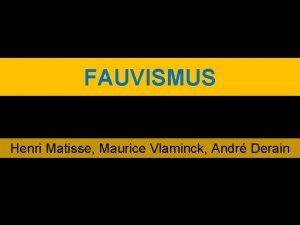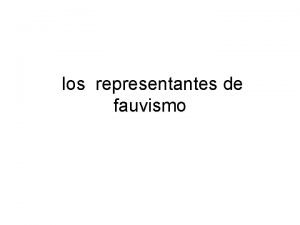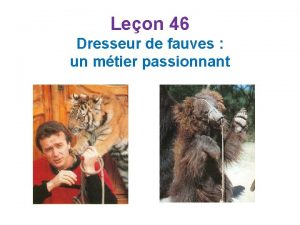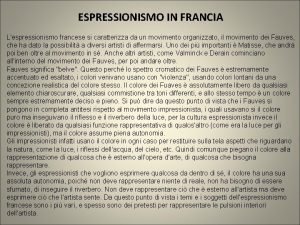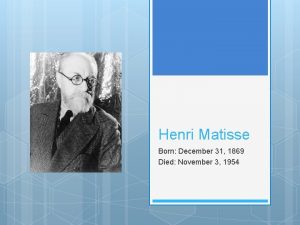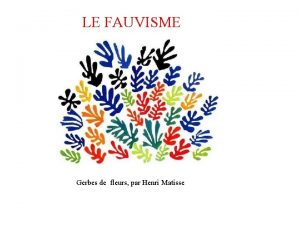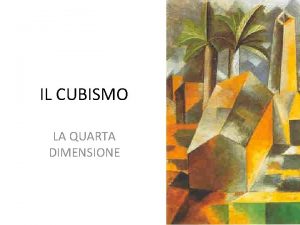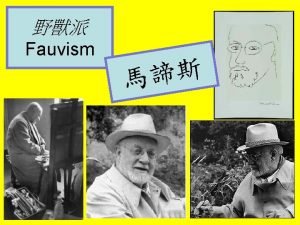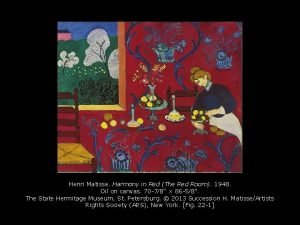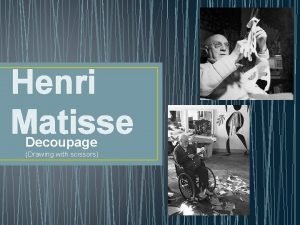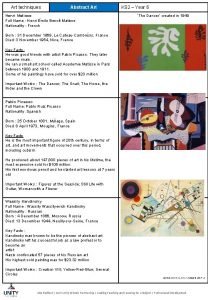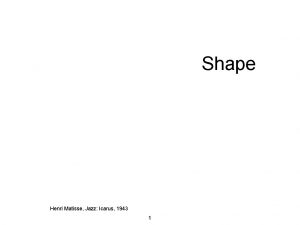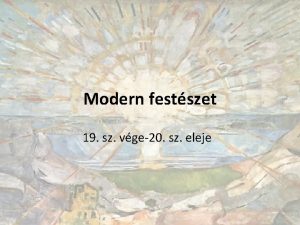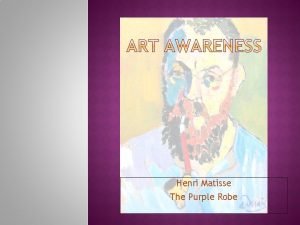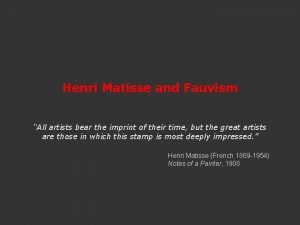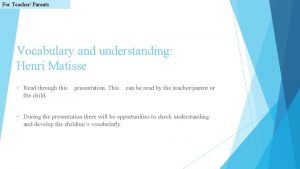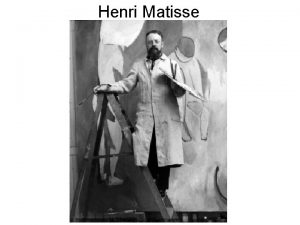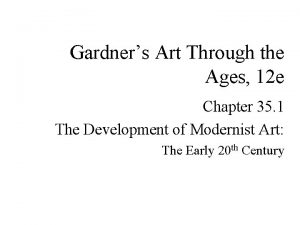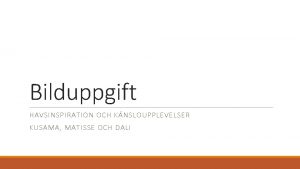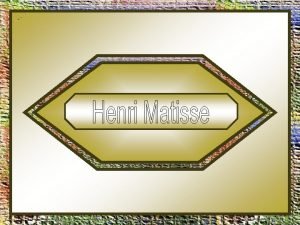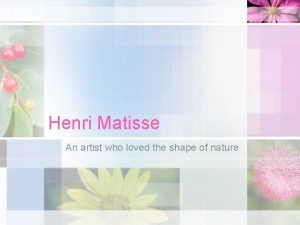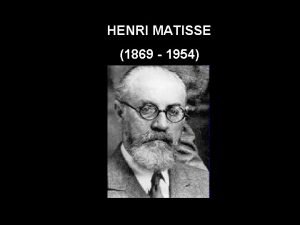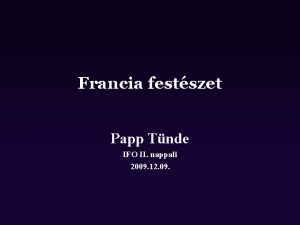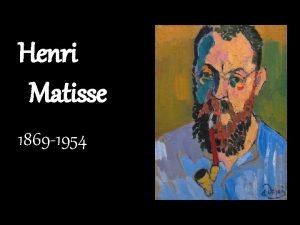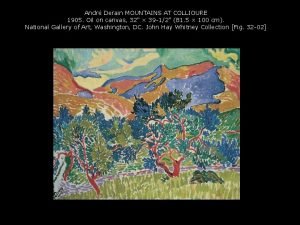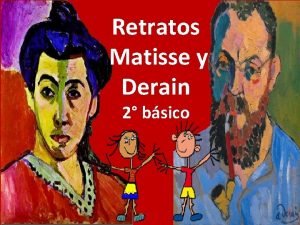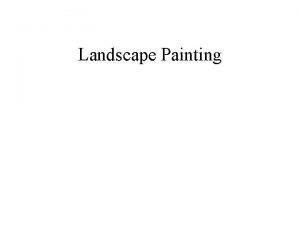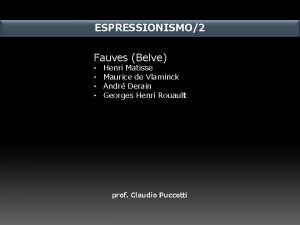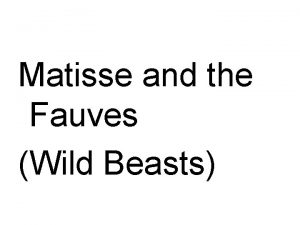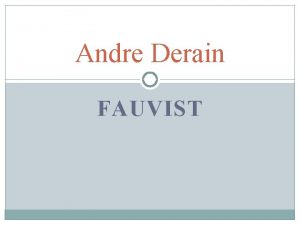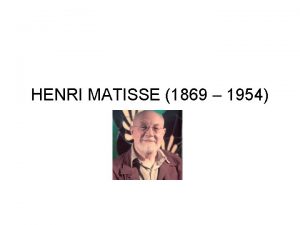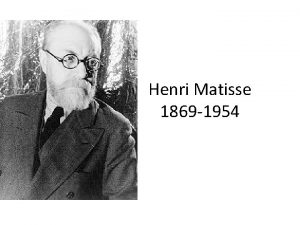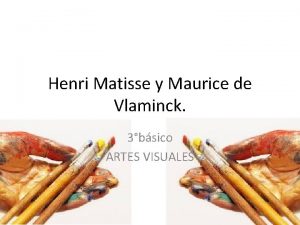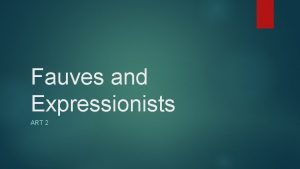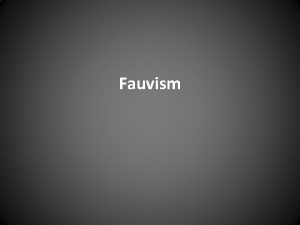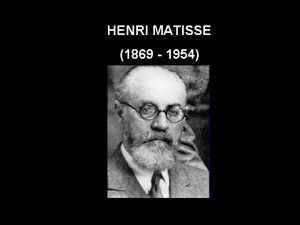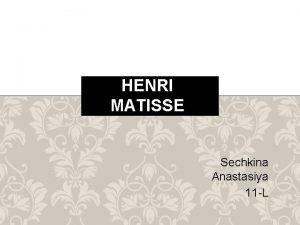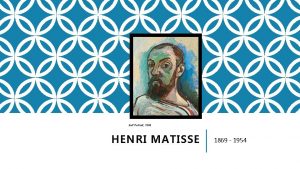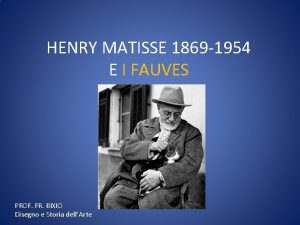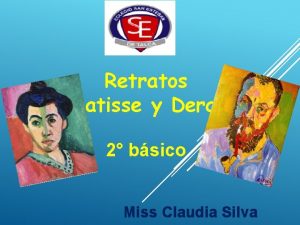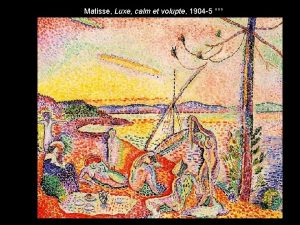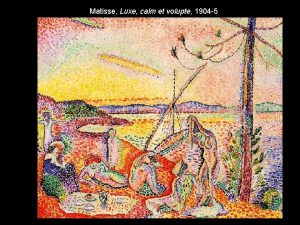Henri Matisse The Fauves Derain de Vlaminck and




























- Slides: 28

Henri Matisse

The Fauves: Derain, de Vlaminck, and Henri Matisse. The Fauves were a group of artists who had been derisively described as “wildbeasts”—fauves—who exhibited at the 1905 Salon d’Automne (fall salon). The critic rejected their explosive colors and impulsive brushwork. Key Ideas: Matisse was interested in the expressive power of pure color. Matisse sought a direct synthesis of color and design.

Vincent van Gogh Sunflowers January 1889, Arles

Paul Gauguin Woman with Mango (Vahine no te Vi) 1892

Henri Matisse The Joy of Life 1905 -6


Henri Matisse Woman with a Hat 1905 Note the vivid and apparently chaotic colors and brushwork. Notes the deliberate disharmonies of color. There is very little modeling— mostly on the face itself and then form is created inversely by green, the complementary of flesh tones. There is no drawing; contours are little more than ragged edges between planes of color. The whole is brushed, especially in the background and towards the sides, with a crudity scarcely seen before—save in certain works of James Ensor (The Entry of Christ into Brussels, 1888).

Henri Matisse Madras Rouge 1907

Henri Matisse The Dessert: Harmony in Red 1908

Matisse wanted “to reach that state of condensation of sensations which constitutes a picture. Perhaps I might be satisfied momentarily with a work finished at one sitting but I would get bored looking at it; therefore, I prefer working on it so that later I may recognize it as a work of my mind. ”

Henri Matisse Le Luxe II 1907 -1908 Color, line, and plane were no longer representative of objects so much as communicative of the underlying mood of the work, in this case the sense of luxurious grace and relaxation suggested by the title. Perspective and modeling have been routed; such space as there was had been reduced to a minimum and light was a function of flat color, rather than a reflection from a lighted surface. Between color and line there was now a balance which Matisse’s mastery maintained for the remaining half-century of his creative life (Hamilton, 171).

Henri Matisse The Dance 1909

Henri Matisse Music 1910

Henri Matisse Zorah on the Terrace 1912

Henri Matisse Le Rifain assis 1912 -13

Henri Matisse View of Notre Dame 1914

Henri Matisse The Yellow Curtain 1915

Paper Cuts Outs (gouaches découpés) In 1941 Matisse was diagnosed with cancer and, following surgery, he started using a wheelchair. Before undergoing a risky operation in Lyon, he wrote an anxious letter to his son, Pierre, insisting, "I love my family, truly, dearly and profoundly. " However, Matisse's extraordinary creativity was not be dampened for long. “Une seconde vie”, a second life, was what he called the last fourteen years of his life. Following an operation he found renewed and unexpected energies. Vast in scale (though not always in size), lush and rigorous in color, his cutouts are among the most admired and influential works of Matisse's entire career. They belong with the grandest affirmations of the élan vital in Western art.










H. C. Bresson. Henri Matisse, Vence, France 1944
 Henri matisse fauvism
Henri matisse fauvism Fue la figura más representativa del fauvismo.
Fue la figura más representativa del fauvismo. Dresseur de fauves
Dresseur de fauves Auguste cazalis
Auguste cazalis Matisse born
Matisse born Définition fauvisme
Définition fauvisme Cubismo matisse
Cubismo matisse 1954-1869
1954-1869 The red room matisse
The red room matisse Matisse decoupage
Matisse decoupage Henri matisse abstract art
Henri matisse abstract art Matisse jazz icarus
Matisse jazz icarus Giacomo balla kutya pórázon
Giacomo balla kutya pórázon Reeksport robe
Reeksport robe Sol agostino nude
Sol agostino nude Henri matisse parents
Henri matisse parents Matisse
Matisse Henri matisse the dessert harmony in red
Henri matisse the dessert harmony in red Surrealism bilduppgift
Surrealism bilduppgift Henri matisse la musique 1939
Henri matisse la musique 1939 Henri matisse organic shapes
Henri matisse organic shapes Matisse 1920
Matisse 1920 Rozstrzelanie powstańców madryckich
Rozstrzelanie powstańców madryckich Henri matisse zöld sugaras portré
Henri matisse zöld sugaras portré Madam matisse
Madam matisse Henri matisse born
Henri matisse born Andre derain mountains at collioure
Andre derain mountains at collioure Retrato de derain
Retrato de derain Frankenthaler mountains and sea
Frankenthaler mountains and sea
